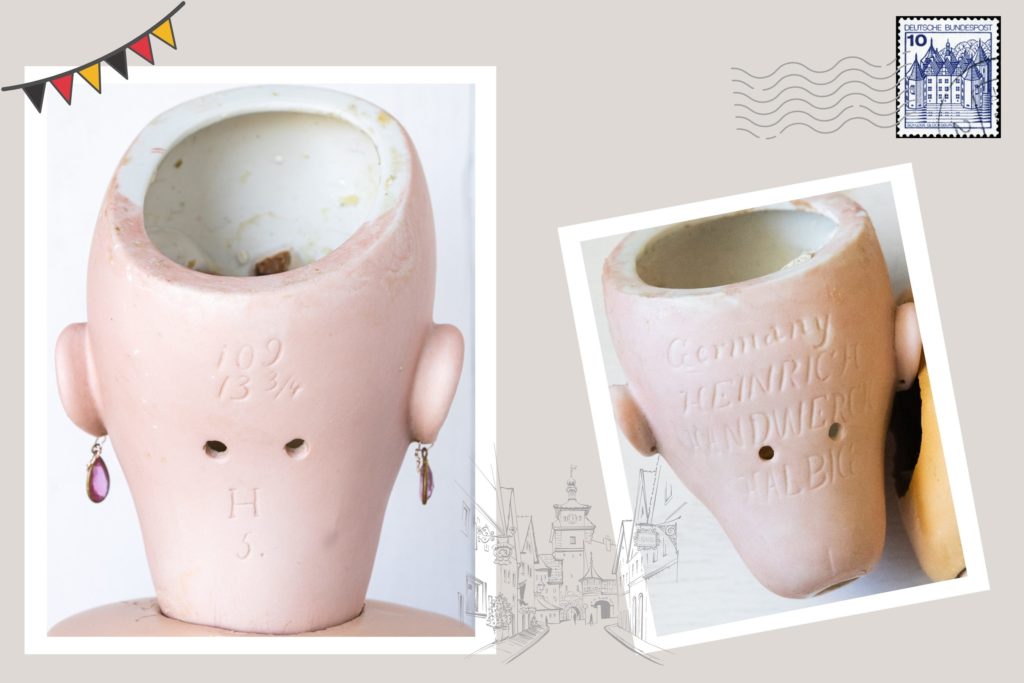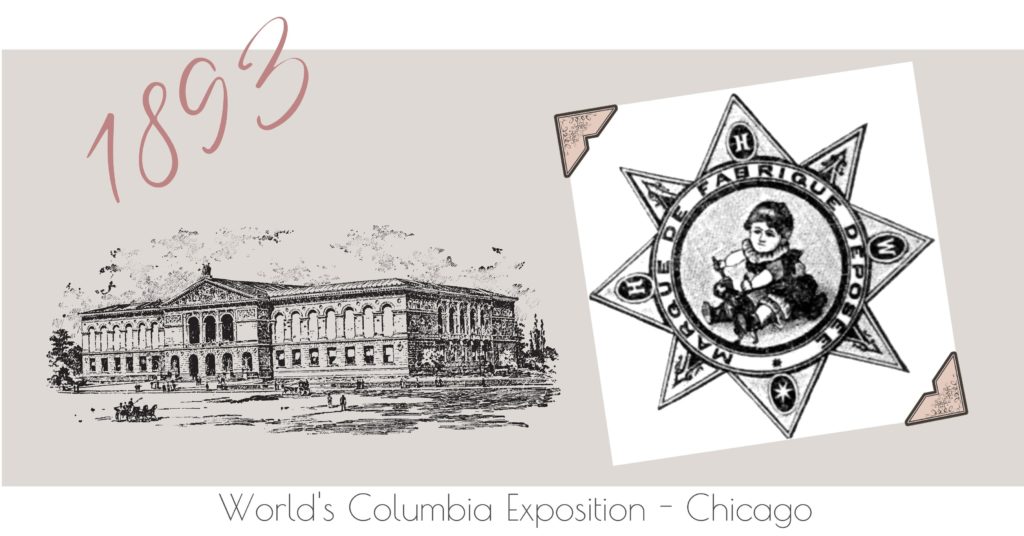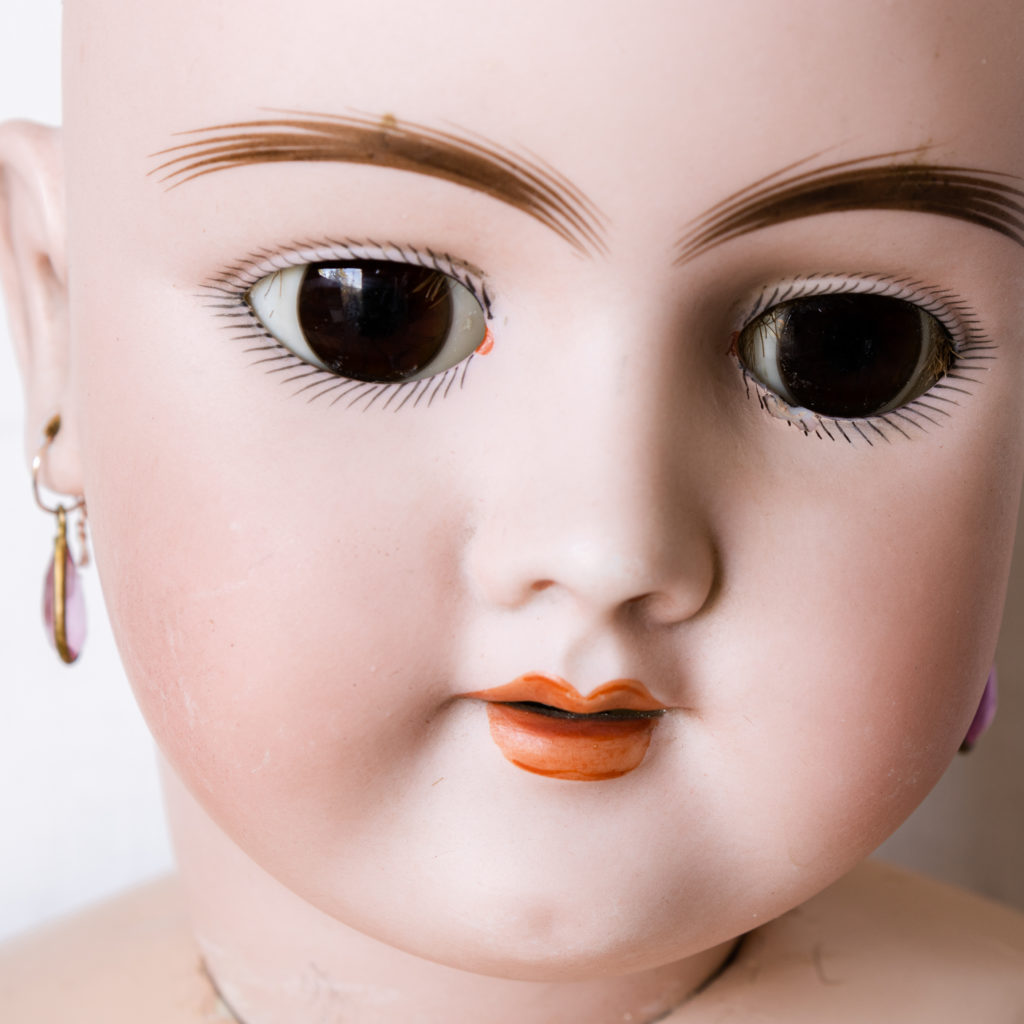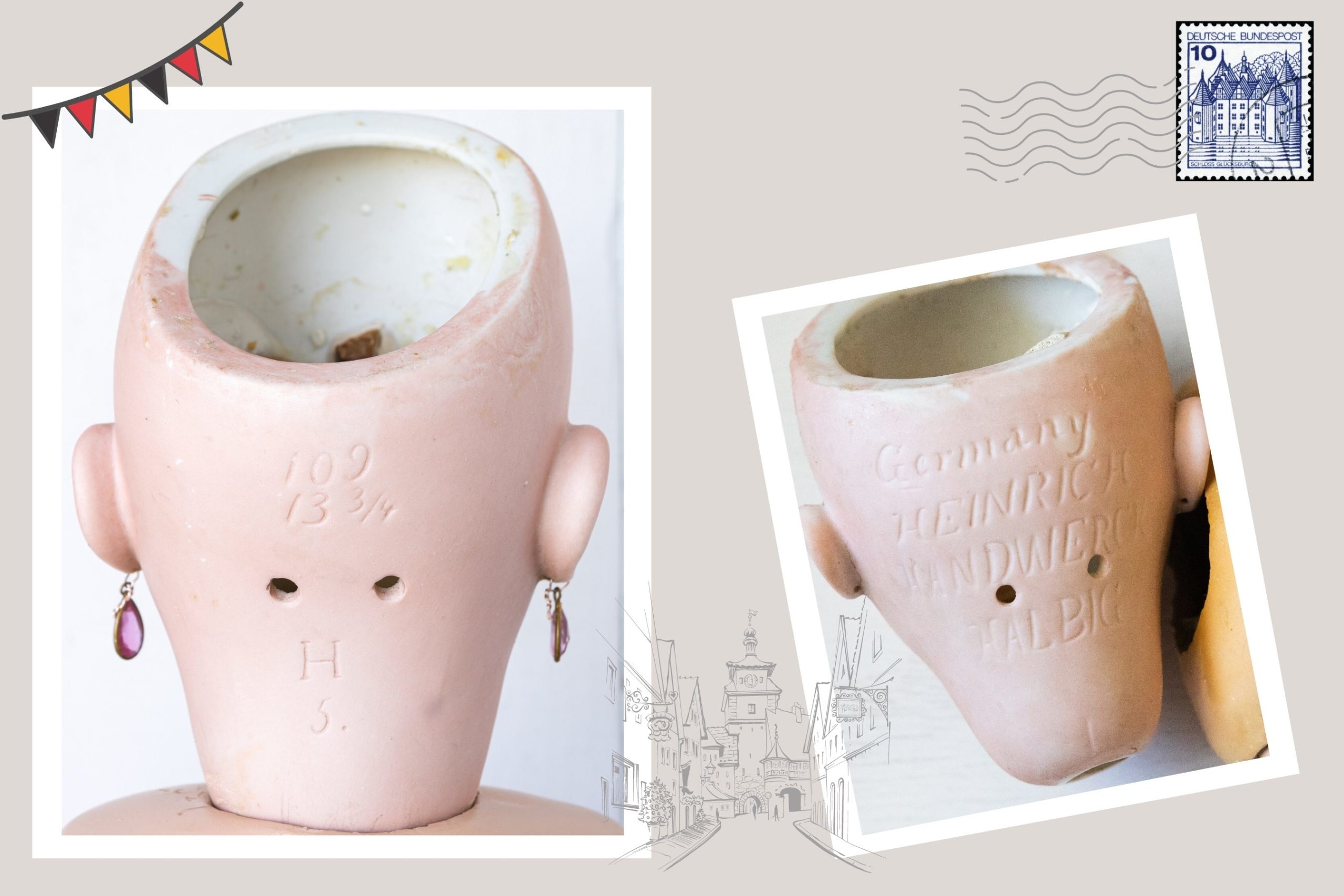Heinrich Handwerck (1858-1902) manufactured dolls in the city of Waltershausen in the area of Thuringia, Germany. Before making dolls he was a banker’s apprentice, worked in a sausage factory, served in the military, and worked in a toy factory in Waltershausen. Handwerck even worked as a traveling salesman selling suitcases. He married Minna Koch in 1884.
1885 Doll Factory and Markings
The Heinrich Handwerck doll factory began in 1885 in Waltershausen, Germany.
Many dolls (not all) actually have the name Heinrich Handwerck incised on the back of the bisque head or stamped in red ink on the back of the torso. Other dolls use different variations of his initials like HH or HHW or something similar. Many Heinrich Handwerck dolls will also have the Simon & Halbig incised mark together. Some doll heads the Heinrich Handwerck company designed or sculpted for the initial molds, but the Simon & Halbig factory made them.
A few famous Heinrich Handwerck dolls were called by the French term for baby: “Bebe Cosmopolite,” “Bebe de Reclame,” and “Bebe Elite.”

In 1887 the company published an ad in the book, “Leuchs’ Adressbuch der Export-Geschäfte vom Deutschen Reich, Oesterreich-Ungarn und der Schweiz” (p. 176). In it they advertised a toy factory in Waltershausen, Germany manufacturing fine ball jointed articulated baby dolls, unbreakable washable doll heads, waxed head dolls, and stuffed leather dolls. They appear again in the 1888 edition.
Heinrich Handwerck in 1893
Heinrich Handwerck of Waultershausen was listed among a group of famous German doll makers in 1893 in the Coburger Zeitung. In the group of names the article listed Alt, Beck & Gottschalck of Nauen or Ohrdruf; Alt & Koch of Ohrdruf; Karl Beck of Ohrdruf; Kämmer & Reinhardt of Waltershausen; J.D. Kestner Jr. of Waltershausen; Heinrich Handwerck of Waltershausen; Wiesenthal, Schindel & Kallenberg of Waltershausen; and Emil Wittzack of Gotha. Together the group of doll makers planned a pavilion for the international exhibition in Chicago in 1893.
The group was advertised at the fair in 1893 as the “Collective Exhibit of the Toy Industry of Gotha-Waltershausen, Ohrdruf” with Emil Wittzack of Gotha as their business manager. The Chicago Commercial Company acted as their representative in Chicago.

In the official German exhibition catalogue, the company advertises its 8 pointed star trademark with the doll in the center. The star has two H’s and a W for Waltershausen with the French words, “Marque de Fabrique Deposee.”
An American German newspaper out of Chicago reported on winners of awards at the Chicago International Exhibition of 1893. Heinrich Handwerck of Waultershausen won an award in the category of toys and fancy goods. Several other German companies won awards in Chicago as well like Cuno & Otto Dressel of Sonneberg, the Bing Brothers of Nuremberg, and others (Abendblatt der Illinois Staats-zeitung, October 13, 1893, Page 4.)
Heinrich Handwerck in 1897
The Leipziger Mess-Adressbuch (Leipzig Trade Fair Address Book) of 1897 provided this listing (translated), “Heinrich Handwerck, Waltershausen (Thüringen), factory fine ball-jointed dolls (“Bébés Cosmopolite”).-O.-V. Peters- Str. 17, I left. Prämiirt Chicago 1893.sign 1-O.”
1898 Patent
Handwerck registered a patent in 1898 for an over-leg ball joint for articulated dolls with joints that could be inserted sideways onto an axle that was elastically mounted under the doll’s torso.
1901 Patent
The German publication Patentblatt announced a patent for Handwerk that read (translated) “Method for assembling doll body parts; Additional 3rd Pat. 116025. Handwerck, Waltershaufen is Th. From 28/2 1901. — H. 25505.” See the 116025 patent from 1900 at the DPMA here.
1902 Kammer & Reinhardt
In 1902 after the death of Heinrich Handwerk, Kammer & Reinhardt purchased the Handwerck doll factory. A Handwerck trademark advertising label with a shield and the Heinrich Handwerck name was then used by Kammer & Rienhardt and was registered even with the US Patent Office but not until 1922.
1904 Win a Heinrich Handwerck Doll!
In 1904 The Forsyth Drug Company gave away life size dolls made by Heinrich Handwerck to three girls under the age of 14 in Rosebud County, Montana. They claimed the doll was worth $50. Customers could cast votes for the girl they thought should win the doll, but one had to pay a fee to cast a vote. With a 25 cent purchase, a mom could cast one vote for her daughter.
1905 Palais Royale Department Store

In 1905 the Palais department store in Washington D.C. advertised Handwerck sample dressed dolls up to $3.
Kann’s Department store in Washington D.C. on Pennsylvania Ave advertised their stock of 800 Handwerck dolls all 22 inches tall. They sold them for $1 though they claimed they were worth $2. These dolls had rolling ball joints at the shoulders, elbows, wrists, thigh, and knees.
Exporter for Handwerck: Hinrichs & Co
The German Doll Encyclopedia by Jurgen and Marianne Cieslik tells of a business man named Wiesel that worked with the Handwercks to import their dolls to New York. Wiesel worked for a company called Hinrich & Co. The company requested that the Handwerks dress their dolls more elegantly like the French dolls and put the language on their packaging boxes in the French language. Minna Handwerck did not seem pleased with the demands of the request according to Cieslik’s notes.
1859 Stellmann, Hinrichs & Co: Importers
In 1859 an ad appears for a “Stellmann, Hinrichs & Co.” describing themselves as importers of German, English, and French Goods. They called themselves “Agents for the Sale of American Manufacturers.” Amongst the many articles they imported were cotton hosiery, gloves, silk, kid, cotton, silk neck ties, cravats, handkerchiefs, trimmings, combs, thread, spool cottons, and more. Dolls and toys are not mentioned. They listed an address of 21 Hanover Street, Baltimore (The Metropolitan Catholic Almanac and Laity’s directory for the United States, Baltimore: John Murphy & Co, 1859, p. 308).
1894 Hinrichs & Co Doll Patent
Hinrichs & Co is associated with a patent for dolls in an annual list of patents from the U.S. House of Representives for the year of 1894. The book located was found in the German national archives. The patent registered on September 18 found on page 394. The mark reads H & C 55 and can be viewed here (Thank you to the kind librarian at the Library of Congress who directed me to it.)
1898 The End of Hinrich & Co.
The Palais Royal announced the great opportunity for a sale of the Hinrich & Co. items in the department store in 1898 due to their “demise” or bankruptcy. (Evening Star, Washington DC, 1898 March 2, p. 11).
It is believed that the company sometimes had the name spelled Hinrichs and sometimes as Hinrich depending on the location and year of the publication.
1902 Heinrich Handwerck Passes Away
When Heinrich Handwerck died in 1902 at the young age of 44, Franz Reinhardt continued the company but still used the old company name of “Heinrich Handwerck.” American newspapers at the turn of the century just before WWI mention Handwerck dolls for sale in the November and December issues. Many of the dolls would then have the Heinrich Handwerck incised mark as well as the KR for Kammer & Reinhardt.
1911 an Inquiry from France
Fun fact: In 1911 a French newspaper put out some various public inquiries. On January 26 someone by the name of M. A. Wellisch of Strasbourg asked for the name of the manufacturer of the doll called “Bebe Cosmopolite,” with a mark of an 8 pointed star with the letters H. H. W. To answer this M. A. Wellisch many years later, let’s tell him that the HHW mark belonged to the German manufacturing company Heinrich Handwerck. Then let’s tell him that the exporter requested the doll have a French name. We apologize for his confusion. The doll’s box would have his name written across the label, perhaps Wellisch didn’t have the box.

The Gimbel Dollar Doll – a Heinrich Handwerck Exclusive
In 1911 and 1912 the new Gimbels department store in New York announced they had more than 500 different kinds of dolls including a Heinrich Handwerck doll 35 inches tall! Gimbels called its 22 inch Heinrich Handwerck doll a “Wonderful Gimbel Dollar Doll” or “Queen of the Toy Store” made exclusively for Gimbel’s three stores. One now might wonder how their 22 inch Gimbel doll differed in 1912 from the 22 inch doll sold at Kanns in Washington in 1905.
According to Gimbels ad, Heinrich Handwerck made this 22 inch doll with curly mohair wigs sewn firmly to the head with blue or brown sleep eyes . They claimed it did not crack easily like the papier mache dolls because it’s body was made of heavy cardboard. This exclusive 22 inch doll had wooden ball-joints at the hips, shoulders, elbows and hands. Gimbels claimed her stringing inside was made of heavy rubber. A fully dress Gimbel Dollar doll cost anywhere from $2.25 to $45 in 1910! Whew – can you imagine the outfit that valued the doll at $45 in 1910? A complete separate outfit came at $13 in 1911.
Even better this 22 inch queen doll had an assortment of hats, dresses, shoes, jewelry and many other accessories to choose from for this lady of fashion. The store directed families to the doll room on the fourth floor to find this Gimbel queen (The Evening World, 1910 Dec. 6, page 11).
1912 Baby Elsie Doll
In 1912 a store in Baltimore advertised a doll named “Baby Elsie” they claimed came from Heinrich Handwerck, “the most famous doll maker in the world.” She had a jointed body, a bisque head, real eyelashes, a sewn wig with either a side part or with bangs, slippers and stockings. She cost only $1.00 in 1912.
1916 Kammer & Reinhardt Take Over Announced
On February 25, a Munich’s newspaper announced Kammer & Reinhardt in Waulterhausen took over the Heinrich Handwerck doll factory in Waltershausen. At that time they had a capital of 1 million marks. The two companies joined to become a public limited company. (The newspaper mistakenly spelled Reinhardt as Freihardt.)
1921 Los Angeles Doll Hospital Praises Heinrich Handwerck
Someone named Wynonah interviewed workers at a doll hospital in Los Angelos run by a Mrs. E. C. Ince. Mrs. Ince said that their imported baby dolls came from Heinrich Handwerck of Bavaria. She called it the center of “doll world.”

1922 Kammer & Reinhardt File Trademark in the US
Kammer & Reinhardt register a trademark with the US Patent and Trademark Office showing the name Heinrich Handwerck on a shield with the Handwerck’s traditional 8 pointed star. They registered the shield trademark in the US on May 11, 1922.

More Reading
Most of the notes in this post are found on public archival databases and the US Library of Congress site. To know more about Heinrich Handwerck’s doll manufacturing business I suggest “German Doll Encyclopedia 1800-1939” by Jurgen and Marianne Cieslik. It has dates of patents, doll marks, and more detailed personal history notes for a clearer story of the Handwerck doll makers.
To see some other German doll markings and faces go to our German Doll Marks Page.
